
Mercedes W15: on the edge of the Technical Regulations to get back to the top!
(Cover picture: Mercedes-AMG PETRONAS F1 Team)
If there's one factor that is never lacking in Mercedes single-seaters, even in the last two poor years in terms of results, it's the wow effect they arouse when they are revealed.
The W15 in black-silver color makes no difference in this regard, presenting a couple of solutions on the edge of the Technical Regulations which - will it prove fast - will cause quite a discussion. From a sporting point of view, this will be Lewis Hamilton's last Mercedes before his switch to Ferrari in 2025, so we can imagine that within the English-German team this car has a deeper meaning than usual: the goal will be to best seal a winning sporting careers like few in the history of Formula 1.
So let's analyze the new Mercedes W15 in detail!
The front wing tries to replicate the "old" Y250 vortex!
The most striking innovation is undoubtedly the invention of the Mercedes engineers regarding the front wing, with the rearward flap having an extremely discontinuous chord. In fact, halfway through its span, a medium-sized chord leaves room for a subtle one, which is there for the sole purpose of satisfying the Technical Regulation requirements.
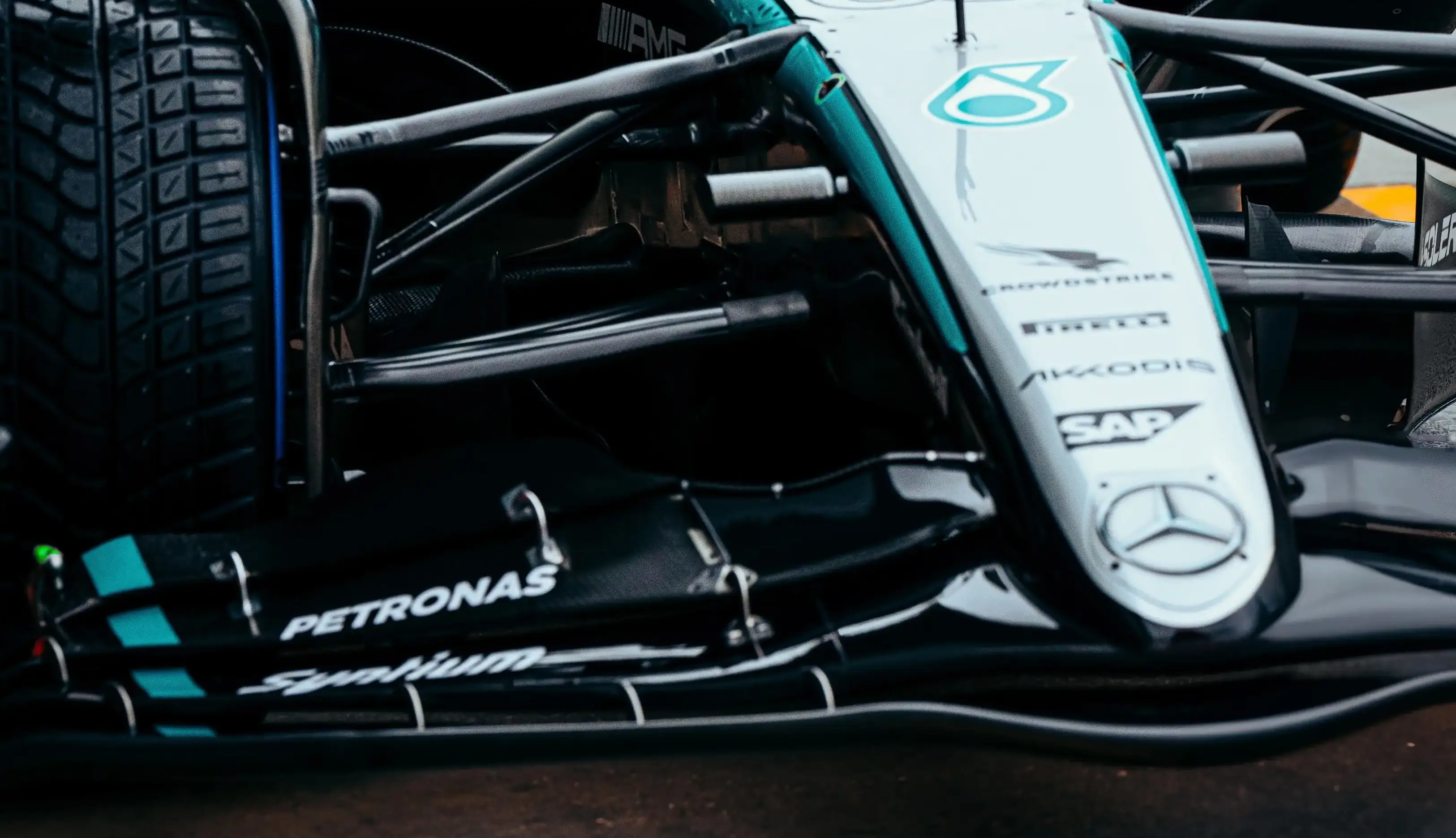
Front wing of the new Mercedes W15 (photo: Mercedes-AMG PETRONAS F1 Team)
The assembly that is so created recalls the front wing profiles in use in Formula 1 from 2009 until 2021, the last year in which the regulations required the presence of a neutral central section from an aerodynamic point of view, thus creating a huge discontinuity in proximity of the part responsible for generating aerodynamic downforce.
Right there, due to the strong discontinuity mentioned, a vortex called "Y250" - due to the fact that it was distant on both sides 250 mm from the center line of the vehicle - detached from the front wing. The Y250 vortex, initially discovered as a negative effect of the old single-seater concepts, over time was exploited to the advantage of the teams themselves, who instead of trying to reduce its effects, decided instead to strengthen it as much as possible and use it to aerodynamically seal the side edges of the floor.
What Mercedes is proposing with the W15 is - potentially - a revival of the Y250 vortex in a much less extensive fashion, having to ensure some degree of continuity in the curvature of the rearward flap. In addition to this, obviously, we must consider that the other two flaps and the mainplane have their own angle of attack, so they are designed to generate donwforce and not to be aerodinamically neutral (as they once were).

Mercedes W15 shown at launch (photo: Mercedes-AMG PETRONAS F1 Team)
Curiously, it must be said, if the images coming from the shakedown (15 km) at Silverstone had not helped us, we wouldn't have been able to behold this technical solution as in the photos released by the team on the unveiling event - see above - the front wing was much more conventional: a short-lived attempt to hide the idea applied on the W15 from his opponents.
Continuing our analysis of the front end, the nosecone is now shorter and connected to the first flap rather than to the mainplane, as happened on last year's W14: the aim is to free up space between the first two elements of the wing, so to direct a portion of the airflow arriving at the car under the floor. In the past, Aston Martin also sought a similar solution, but with its last two single-seaters they partly abandoned the idea... At Mercedes they will therefore have to be skilled at managing such a front wing, since the nosecone doesn't seem designed to be modular like that of the Red Bull RB20.
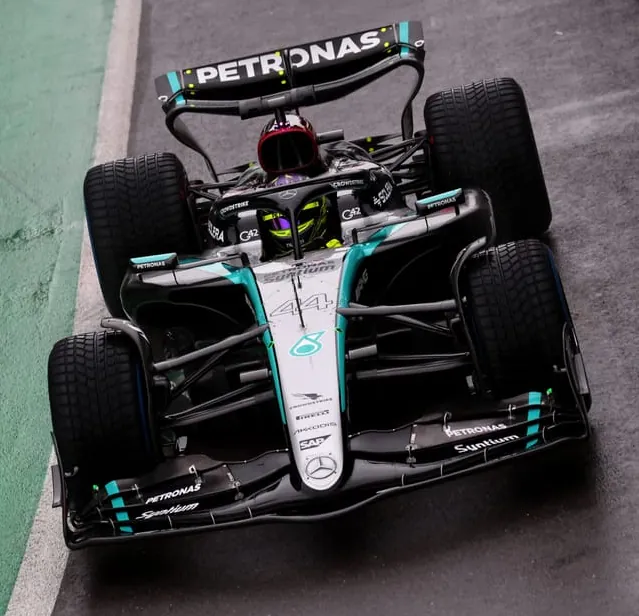
Front view of the Mercedes W15 during the shakedown at Silverstone (photo: Mercedes-AMG PETRONAS F1 Team)
As regards the suspension layout, however, the push-rod configuration adopted last year remains. As expected, once the potential that the anti-dive characteristic provided Red Bull had been ascertained, at Brackley they also designed such geometries that replicated this effect: this can be seen by observing how the upper suspension triangle has the front leg positioned very high, while the rear one (less visible in the photo above) is leaning downwards. The angle created is what allows, as we know, the stabilization of the entire front end due to the anti-dive effect.
Vehicle bodywork: Mercedes inspired by Red Bull, which in turn has copied... Mercedes!
The previous photo also allows us to understand very well the shape of the sidepod inlets, equipped with a rather large front surface compared to competitors from Ferrari and Red Bull, to name just two...
Their shape is vaguely triangular, similarly to the Alpine A524, but the most important spec to underline is that the lower "lip" and the upper "lip" don't have different extensions; the latter, taking the cockpit as a reference, is positioned at the maximum height as far as the regulations are concerned.
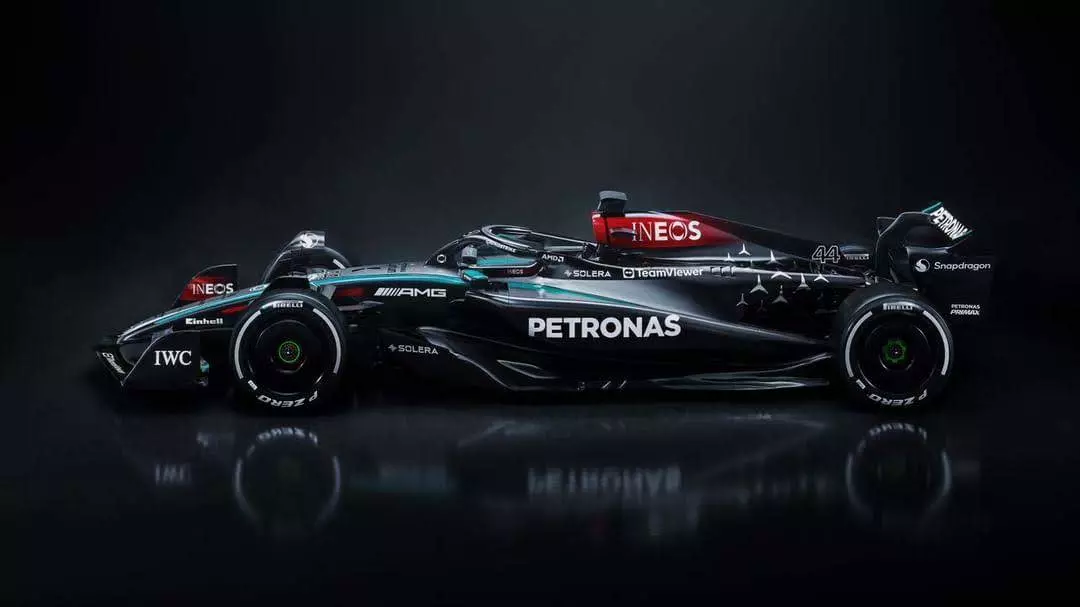
Side view of the new Mercedes W15 (photo: Mercedes-AMG PETRONAS F1 Team)
The side view allows us to analyze the aerodynamic philosophy chosen by the engineers led by James Allison: with the necessary differences, the downward trend of the sidepods recalls the concept chosen in the first place by Red Bull. The common intent is in fact to - in addition to correctly pressurize the undercut area - to create a downwash effect, i.e. to seek a downward curvature of the airflow in order to channel ot right to the upper wall of the diffuser.
The funny thing is that if on the one hand Mercedes tried to take inspiration from the Red Bull RB19 as a thorough concept, on the other hand in Milton Keynes they followed the exact opposite path for the new RB20! In short, if the performance levels at the beginning of the season were to be similar to those at the end of 2023, this would be proof that the interpretation of the rules of the team of Verstappen and Perez is overall better than that of the team of Hamilton and Russell, regardless of what aerodynamic effects are sought in the sidepods area.
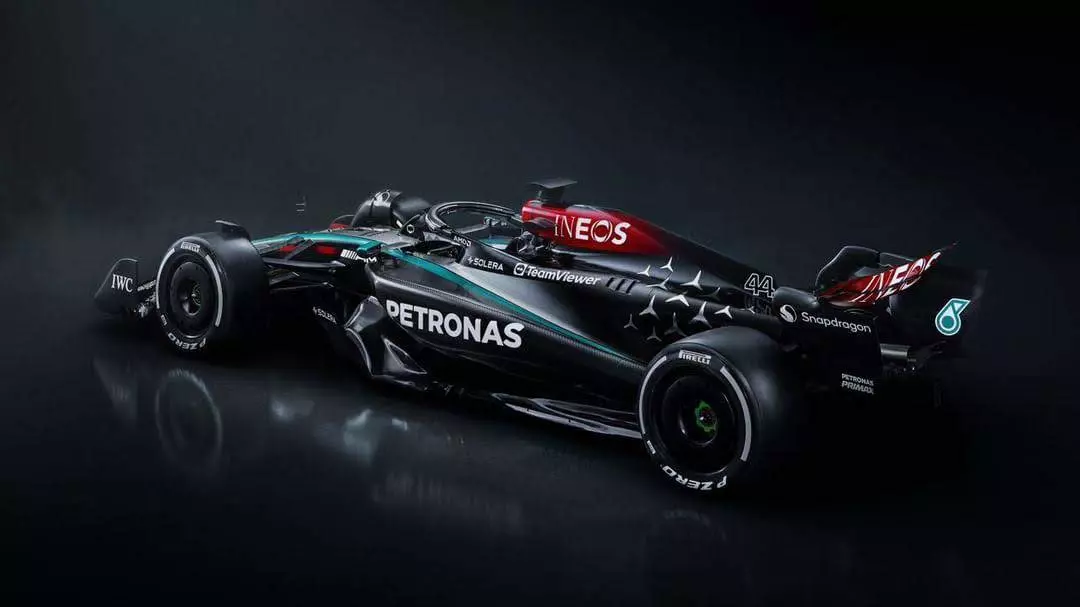
Rear view of the new Mercedes W15 (photo: Mercedes-AMG PETRONAS F1 Team)
Still in the center of the car, but moving upwards, we can observe how on both sides of the engine cover there are once again the two bulges that we talked about in previous articles on Ferrari and Red Bull. Wanting to find a similarity with one of these two teams, I would say that the solution on the W15 is more similar to that of the SF-24, since in both cases a decreasing trend of these two elements is not present. As always in these cases, we have now understood that the function of this engine cover configuration is to best work along the rear wing, beam wing and diffuser assembly...
The rear suspension follows the 2024 trend and is a push-rod one!
At the rear, the most important innovation is the transition that the Brackley team has made from a pull-rod type suspension layout to a push-rod one, similar to what has now been done by 8 out of 10 teams on the grid (only Ferrari and Haas remain faithful to the pull-rod suspension at the rear).
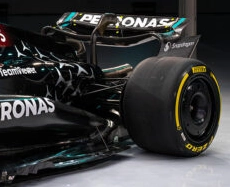
Detail of the rear suspension of the new Mercedes W15 (photo: Mercedes-AMG PETRONAS F1 Team)
As now experienced by all the technical departments, the advantage of a push-rod at the rear end lies in the greater aerodynamic neatness that is created in a crucial area such as the channels leading to the diffuser. However, this doesn't mean neglecting the importance that the mechanical needs can have in delicate phases of driving, as Technical Director James Allison himself explains...
"We put a lot of attention on improving the rear axle of the previous car, which was a bit unpredictable. We worked on this to try and create a car that is easier for the drivers: at the beginning of a corner, when you brake hard and you roll into a corner, the rear axle has to be solid. And then, as you approach the apex, the car has to feel progressively more agile and eager to turn. We tried to achieve exactly this effect with the W15"
James Allison
Finally, a special mention for the rear wing, which between the launch and the shakedown we've already seen in two different versions:
- The one at the launch is equipped with a DRS flap disconnected from the rest of the wing, and in theory this reduces the aero losses that are common in more conventional rear wings in this generation of cars;
- The one seen in the shakedown is much more conventional and similar to last year's W14, with a very large fillet radius which, if on the one hand helps to avoid generating a turbulent wake, on the other is a hint of some aero losses in the lateral areas of the wing itself...
It is possible that the engineers from Brackley will opt for one or the other configuration depending on each circuit on which they will race during the season, therefore basing their choice on the particular aerodynamic downforce and efficiency requirements that they will present.
"We've worked hard to create a car with less drag and better cornering performance. We've also made some improvements in areas where we had room for improvement, including the DRS effect"
James Allison
What to expect from the Mercedes W15 in the Bahrain testing?
The development direction at Mercedes over the last two years has often been marked by a lack of understanding of the behaviour of their cars, and we have often seen profound upheavals that have even worsened their competitiveness. Something in stark contrast to the dominant team that we admired between the 2014 and 2020 seasons, also including 2021 albeit with a Red Bull that was already on par with them.
In this season, therefore, starting from the tests in Bahrain which will start on February 21st, the keyword must be "understanding". Will the Brackley engineers demonstrate that they have 100% understood the physical aspects underlying the behaviour of their new W15 on track, even if the baseline doesn't prove to be up to the level of their rivals, I expect them to be able to recover; if, conversely, the new racecar proves to be immediately competitive, let's not forget that at Mercedes they know very well how to win a World Title...
Index
Mercedes W15: on the edge of the Technical Regulations to get back to the top!